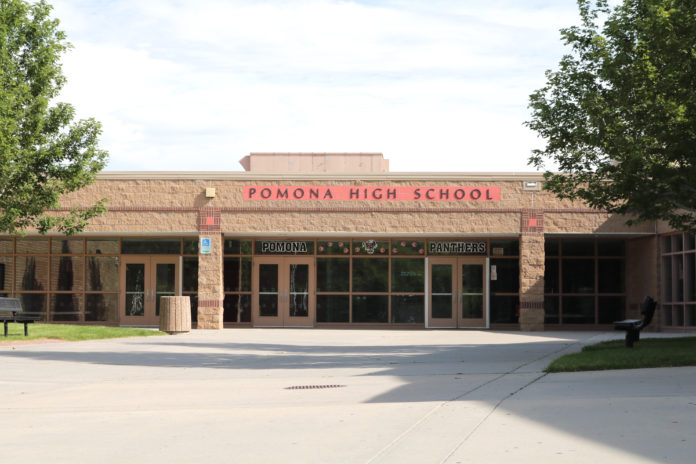
The Colorado Supreme Court will return for a second round of oral arguments this month. On Tuesday, the justices will appear at Pomona High School in Arvada, where they’ll hear two cases as part of its Courts in the Community program. In the first case, the City of Boulder says it is immune from liability for injuries a woman suffered after falling on an uneven sidewalk in the city. In the second case, the justices will consider questions about the admissibility of expert witness testimony about bullet trajectories.
Maphis v. City of Boulder
The trouble began with a bumpy sidewalk in Boulder. In 2017, Joy Maphis was walking in the city when she tripped on a slab of pavement that was raised two and a half inches above the adjacent slab. She landed on her elbows and face, shattering her right elbow and breaking her left. She also needed stitches in her lip.
Maphis sued the city over her injuries. But the Colorado Governmental Immunity Act protects public entities from liability in all claims for injury that lie in tort or could lie in tort, with a few exceptions. One of those exceptions is if there is a “dangerous condition” that interferes with the movement of traffic on a road, street or sidewalk.
During a hearing to determine whether the government has immunity, Maphis testified that she believed the uneven sidewalk was an “unreasonably dangerous condition” because its hazards were invisible to her. If there had been cones or other markings, Maphis testified, she could have avoided injury.
The city, which moved to dismiss the lawsuit, argued that the damaged sidewalk didn’t constitute a “dangerous condition” because it didn’t present an “unreasonable risk” as those terms have been defined in the CGIA and interpreted by the Colorado Supreme Court in its 2018 decision City and County of Denver v. Dennis.
The lower court found the sidewalk’s condition constituted an unreasonable risk to the public and Maphis overcame her burden to show Boulder waived its immunity. But the Court of Appeals reversed the decision and remanded the case with instructions to dismiss the lawsuit.
The Colorado Supreme Court will consider whether the Court of Appeals applied the correct standard of review and whether it erred by holding that the sidewalk didn’t constitute an unreasonable risk and a dangerous condition for the purposes of the CGIA.
The case has drawn the attention of several groups, including the Colorado Trial Lawyers Association, the Colorado Municipal League and the Colorado Intergovernmental Risk Sharing Agency, which have filed amicus briefs in the appeal.
People v. Ornelas-Licano
In 2014, police had a warrant out for Jorge Ornelas-Licano. When they learned of his location, six officers went to arrest him. They found him sitting in his parked truck and turned on their lights, but Ornelas-Licano fled in his vehicle. Another officer, Jacob Schneider, heard about the chase over the radio, headed toward the scene and turned on his lights. A shot was fired at Schneider from Ornelas-Licano’s gun but missed, and the suspect continued to flee until he was arrested at a Dollar Store the next day.
Ornelas-Licano was charged with multiple crimes, including attempted murder. The defendant claimed his gun went off by accident as he was shifting gears and holding his gun with the same hand.
At trial, both sides presented experts who analyzed ballistics evidence based on a hole in Ornelas-Licano’s windshield. The prosecution’s witness, Detective Dan Gilliam, testified that the shape of the bullet hole was inconsistent with the defendant’s claim that he was holding the gun near the stick shift. Gilliam testified he had performed two tests to recreate the shooting using the same gun, type of bullet and windshield — one shot from a “natural shooting position” and another from the stick shift. Gilliam said that, based on the tests, he thought the shot had come “closer to the natural shooting position” than the stick shift.
The defense’s witness, Jeff Saviano, a defense ballistics expert and law enforcement criminologist, said there were “too many unknowns and too many variables in this particular case” to draw a conclusion about the gun’s position at discharge.
A jury found Ornelas-Licano guilty of attempted second-degree murder and other offenses. He appealed, raising claims that the trial court erroneously admitted Gilliam’s testimony. A split division of the appellate court agreed that Gilliam’s education and experience didn’t qualify him to opine on the relationship between the angle of impact and shape of the bullet hole and ordered a new trial for the attempted murder offense.
The state now appeals that decision, arguing the Court of Appeals majority failed to apply the appropriate legal standard by “improperly import[ing] a stringent reliability test from the Sixth Circuit that was designed to apply to scientific-based testimony,” while Gilliam’s opinion was experience-based, not science-based. The majority “further misconstrued the appropriate standard” by focusing on whether it agreed with Gilliam’s conclusion rather than whether he used reliable means to arrive at his opinion, the state says in its opening brief.
Ornelas-Licano says the Supreme Court should not have taken the case at all and that the state’s distinction between science- and experience-based expertise is “unhelpful.” Colorado Rules of Evidence 702 and 403 apply to all types of expertise, Ornelas-Licano says, and Gilliam’s testimony failed to meet tests for admissibility under both rules.

